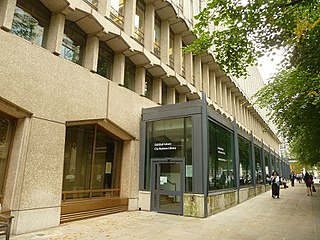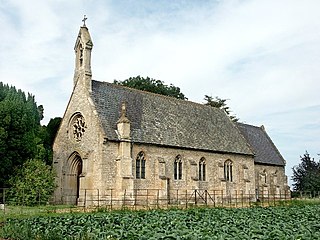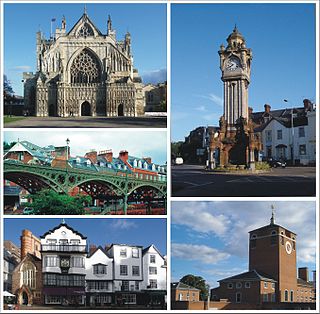
George Abbot was an English divine who was Archbishop of Canterbury from 1611 to 1633. He also served as the fourth chancellor of the University of Dublin, from 1612 to 1633.
Peter Whittle was a mathematician and statistician from New Zealand, working in the fields of stochastic nets, optimal control, time series analysis, stochastic optimisation and stochastic dynamics. From 1967 to 1994, he was the Churchill Professor of Mathematics for Operational Research at the University of Cambridge.

The Guildhall Library is a public reference library in London, England, specialising in subjects relevant to London and its history. It is administered by the Corporation of London, the government of the City of London, which is the historical heart of London. The collection has its greatest depth on topics specifically concerned with the City, but also contains much material on other parts of metropolitan London.

Brothertoft is a village in the civil parish of Holland Fen with Brothertoft, in the Boston district, in the county of Lincolnshire, England. It is about 4 miles (6.4 km) northwest from the market town of Boston.

King's Norton and Northfield Urban District was a local government administrative district in north Worcestershire, England, from 1898 until 1911. Much of its area was afterwards absorbed into the neighbouring Borough of Birmingham, under the Greater Birmingham Scheme, and now constitutes most of the city's southern and southwestern suburban environs.
Tollcross station was a railway station in the east end of Glasgow, Scotland. It was opened by the Caledonian Railway as Tollcross on 1 February 1897.

John Gellibrand Hubbard, 1st Baron Addington PC, was a City of London financier and a Conservative Party politician.
The High Sheriff of County Galway was the Sovereign's judicial representative in County Galway. Initially an office for lifetime, assigned by the Sovereign, the High Sheriff became annually appointed from the Provisions of Oxford in 1258. Besides his judicial importance, he had ceremonial and administrative functions and executed High Court Writs.
Crockford's Clerical Directory (Crockford) is the authoritative directory of Anglican clergy and churches in the United Kingdom and Ireland, containing details of English, Welsh, Scottish and Irish benefices and churches, and biographies of around 26,000 clergy in those countries as well as the Church of England Diocese in Europe in other countries. It was first issued in 1858 by John Crockford, a London printer and publisher.
The City of Bath Technical School in Bath, Somerset, England had various roles from the late 19th century until 1970. It obtained its official name when technical schools were formally introduced in Bath between the years 1892 and 1896, and at first was housed in a new extension of the Guildhall. The school was transformed in the early 20th century, when it was combined with several other institutions, and then evolved through various sites and roles until its closure at Brougham Hayes, Lower Oldfield Park in 1973 after being renamed in 1971 as Culverhay School.
Frederic Festus Kelly was a high official in the British Post Office. He was also the founder of Kelly & Co., which published the Kelly's Directory, a sort of Victorian-era "Yellow Pages" that listed all businesses, tradespeople, local gentry, landowners, charities, and other facilities located in a particular village, city or town.
Isaac Slater was a British publisher of trade directories.
James Pigot was a British publisher of directories, and a pioneering publisher of trade directories.
The following is a timeline of the history of the city of Kingston upon Hull, East Riding of Yorkshire, England.

The following is a timeline of the history of the city of Exeter, Devon, England.

The Yorkshire Grey was a common name for public houses in England, some still survive but most have now closed or changed their name. They were named for the Yorkshire Grey Horse, a breed commonly used to pull brewery drays.
The following is a list of towns in England and Wales which formed local board districts under the Public Health Act 1848 or local government districts under the Local Government Act 1858.

The Swan with Two Necks was a coaching inn in the City of London that, until the arrival of the railways, was one of the principal departure points for travel to the north of England from London. Its site was given over in the early 1860s to a goods and parcels depot for a firm of railway agents and carriers.

The Bull and Mouth Inn was a coaching inn in the City of London that dated from before the Great Fire of London in 1666. It was located between Bull and Mouth Street in the north and Angel Street in the south. It was once an important arrival and departure point for coaches from all over Britain, but particularly for the north of England and Scotland. It became the Queen's Hotel in 1830 but was demolished in 1887 or 1888 when new post office buildings were built in St Martin's Le Grand.

Cardigan Guildhall, is a municipal building in Pendre, Cardigan, Ceredigion, Wales. The structure, which is now used as an art gallery and community events venue, is a Grade II* listed building.










